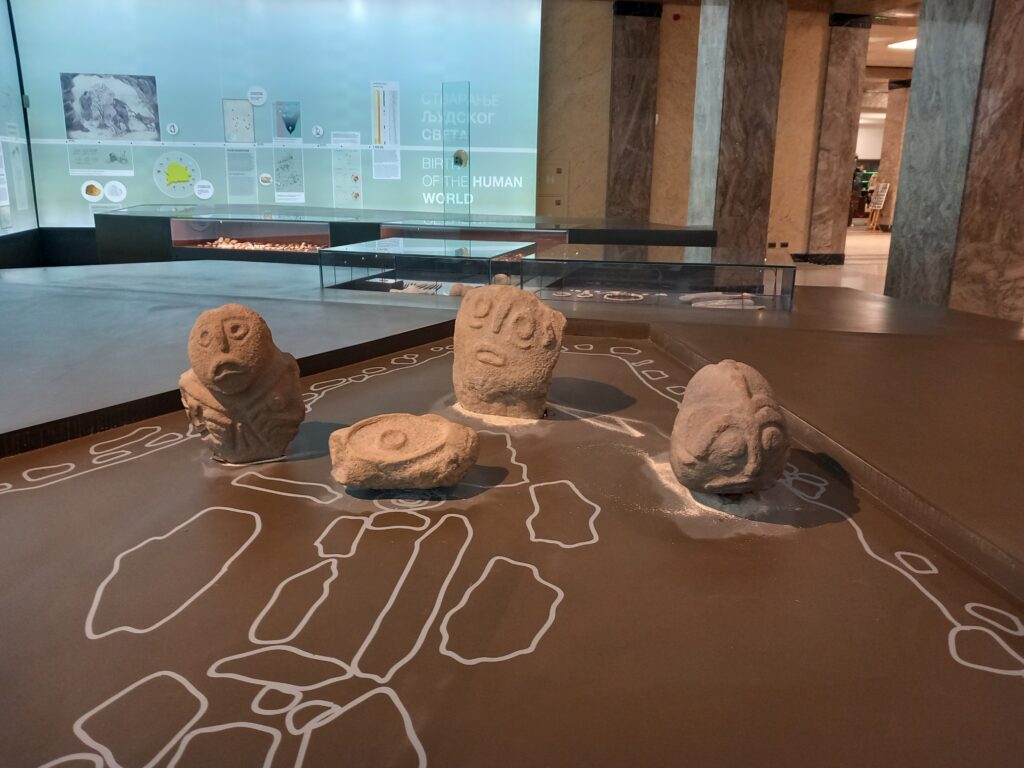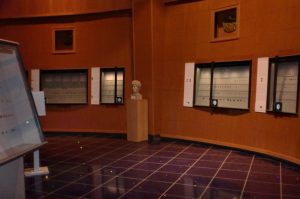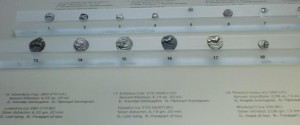
National Museum Serbia in Belgrad has a great archaeological collection and very beautiful presentation. Visitors get good insight in (pre)historic life in this region where rivers dominate the landscape and many different tribes shaped the local customs.
Do not go to the National Museum Serbia, people told me. Apparently, it is a prominent project of the actual president that many citizens of Belgrad hate. However, archaeological findings house in this ‘Narodni Muzej Srbije’ so I went there anyway and I did not regret. The enormous hall on the ground floor has a nice atmosphere and good overview over the ages, starting in the 9-7th millenium BCE with the extensive findings of Lepenski Vir – like the figurines on the photograph above. Mesolithic artists shaped sandstone boulders from the river into sculptures and altars.

The National Museum Serbia contains many other precious objects and they know how to show them as you can see here. It is a joy to walk and look around.



Fortunately, always great to see, they have ancient jewelry! I was particularly intrigues by the ‘wristband’, an ornament that people wore 1500-1000 years BCE. I’d loved to try it for myself. More in general, why are jewelry makers not more often inspired by ancient times and the often spectacular ideas of our ancestors? The silver jewelry shown here date from 500-400 BCE.



These are just a few impressions. I really recomment that you go and see for yourself as there is so much more than what I show. The National Museum Serbia houses in a former bank and they use that as an advantage by housing a numismatic collection in two former bank vaults. Here you see pictures of a coin of Emperor Valentinian 1 (364 BCE) – of the oldest Serbian coin (1230 AD) with Christ blessing King Radoslav – and of a beautiful Yugoslavian banknote (1931). If you like ancient coins, the numismatic collection alone is rich enough to pay a visit to.



The first floor has lots of medieval objects, many of them religious. The top floors have paintings – I spotted quite some Dutch ones among many international famous names. For this blog, I think the Serbian painter Uros Predic (1857 – 1953) is interesting to show with some very fine Realistic paintings: ‘An orphan at his mother’s grave'(1888) and ‘Fugitives from Herzegovina'(1889). I was deeply moved while watching them.


Interested in archaeology and museums? You may also like:
Musée National Luxembourg
Musée d’Angoulême
Archaeological Museum Amman
Archaeological Museum Gaziantep


 verview of it’s history and socio-economic life. You learn about the history of whalers, find a full whale skeleton and of course the famous little seals, see a complete
verview of it’s history and socio-economic life. You learn about the history of whalers, find a full whale skeleton and of course the famous little seals, see a complete  room, kitchen and laiterie like they had in the old times; but apart from that, there are many great, even amazing artefacts that tell you maybe even more about life in Borkum. This was a museum that gave me much more than I expected when I entered. It is impossible to resume, so I show you here the artefacts that impressed me most:
room, kitchen and laiterie like they had in the old times; but apart from that, there are many great, even amazing artefacts that tell you maybe even more about life in Borkum. This was a museum that gave me much more than I expected when I entered. It is impossible to resume, so I show you here the artefacts that impressed me most:
 A garland made out of the hair of the deceased… Elsewhere in the museum, jewelry made out of female hairs can be found. My mouth fell open; I find it a bit spooky but here it seems to be a piece of art. One thing is sure, the results are beautiful!
A garland made out of the hair of the deceased… Elsewhere in the museum, jewelry made out of female hairs can be found. My mouth fell open; I find it a bit spooky but here it seems to be a piece of art. One thing is sure, the results are beautiful! A 18th century cistern where water was collected both from the rain and from groundwater. It is big and covered with Dutch blue painted tiles who were valuable already in that era so the owner must have been very rich. The cistern kept the water cool and fresh. It is quite unique, no other cistern like this was found in the north of Germany.
A 18th century cistern where water was collected both from the rain and from groundwater. It is big and covered with Dutch blue painted tiles who were valuable already in that era so the owner must have been very rich. The cistern kept the water cool and fresh. It is quite unique, no other cistern like this was found in the north of Germany. A 19th century bucket that served to collect the household money. It hang at a beam in the kitchen. That is what attracted my attention; that there were times where people hang their money in a bucket in the kitchen…. I liked the idea that it was safe there, out in the open!
A 19th century bucket that served to collect the household money. It hang at a beam in the kitchen. That is what attracted my attention; that there were times where people hang their money in a bucket in the kitchen…. I liked the idea that it was safe there, out in the open!



 und at the beach of Borkum in 1971: a silver coin that was made in Hedel, the Netherlands which is…. the village where I was born. There is a long story to tell about coins from my native village Hedel … another time… For now: I was – happily – surprised to find this particular coin so far away from home. It proves that you will never know how far the things you make can reach, and that the extent to what it reached can be observed until centuries afterwards… so great!
und at the beach of Borkum in 1971: a silver coin that was made in Hedel, the Netherlands which is…. the village where I was born. There is a long story to tell about coins from my native village Hedel … another time… For now: I was – happily – surprised to find this particular coin so far away from home. It proves that you will never know how far the things you make can reach, and that the extent to what it reached can be observed until centuries afterwards… so great!

 And it presents plenty of memorial coins, and coins of special sites where I found Amsterdam among them.
And it presents plenty of memorial coins, and coins of special sites where I found Amsterdam among them.
 Last but not least: the library they have offers books in 5 or 6 languages, not just about coinage but also about history and art of the region. It is an excellent collection for those who want to study and it seems to be an undiscovered place: you can sit there in complete tranquillity, surrounded by friendly workers who are happy to welcome anyone interested in their cultural heritage.
Last but not least: the library they have offers books in 5 or 6 languages, not just about coinage but also about history and art of the region. It is an excellent collection for those who want to study and it seems to be an undiscovered place: you can sit there in complete tranquillity, surrounded by friendly workers who are happy to welcome anyone interested in their cultural heritage. Go to Nicosia, Cyprus and this museum with a spectacular overview of Cypriot coinage. It looks like a small museum in terms of square meters: just one room within the Nicosia headquarters of the
Go to Nicosia, Cyprus and this museum with a spectacular overview of Cypriot coinage. It looks like a small museum in terms of square meters: just one room within the Nicosia headquarters of the  Here is a job to do for someone who likes puzzles; one of the last undeciphered languages!
Here is a job to do for someone who likes puzzles; one of the last undeciphered languages!